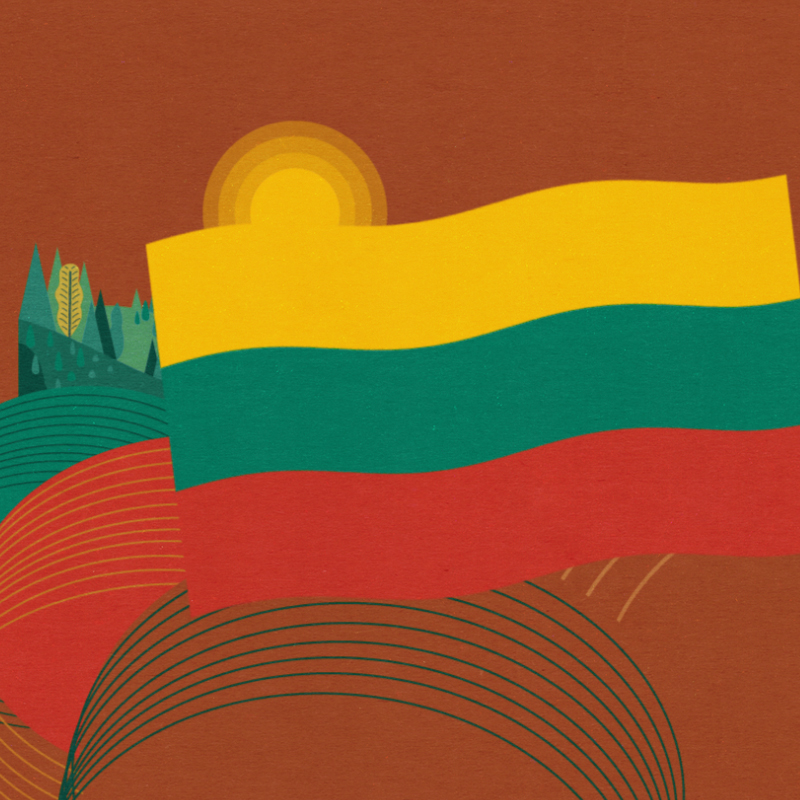What Do the Flag and the Spirit of the Dead Have In Common?
> BACK TO 100 STORIESListen to this text (Lithuanian):
The flag is one of the most important symbols of a country. The colors of the flag, their arrangement and the objects depicted on it indicate the values of that country. It is believed that the first flags were used in the Middle Ages on battlefields. People hoped that the flag would act as a magical safeguard, protecting soldiers from death and bringing victory. This belief could be related to the Lithuanian word vėliava [Eng. flag] which derives from the word vėlė [Eng. ghost], or the spirit of the dead. That is, it may also be related to this belief. In other words, Lithuanians marched to war with a flag which summoned the spirits of their ancestors and ensured their support. Today, support, or simply a reminder, that every citizen of the country has invisible ties to others and is responsible for them, is not only needed in war. That’s why flags are waved at rallies, sporting events, international meetings, on public holidays or simply to express pride in one’s country.
The main Lithuanian flag consists of three colors – yellow, green and red. This flag is not very old, it was created at the beginning of the twentieth century. Why were these particular colors chosen? The creators of the flag chose the colors that are most commonly found in traditional Lithuanian clothing. So – the ones reminiscent of our ancestors. After examining the national costumes worn in various regions of Lithuania, it was decided that green and red colors were most used most often. However, the committee responsible for creating the flag – scientist Jonas Basanavičius, painter Antanas Žmuidzinavičius and museologist Tadas Daugirdas – decided that a green and red flag would be too dull. Therefore, they decided to add the yellow as well. Each color has a symbolic meaning: yellow stands for the sun, light, and prosperity; green – for nature, freedom, and hope; red – for earth, courage and blood spilled fighting for the homeland. The tricolor was first raised on 11 November 1918.
The tricolor is not the only Lithuanian flag. The oldest Lithuanian flag is red. It depicts a white rider called Vytis and the Columns of Gediminas. This flag was first mentioned in the fifteenth century and may have been used even earlier. Initially it represented the Grand Duke of Lithuania, and later it symbolised the entire Grand Duchy of Lithuania.
When Lithuania was occupied by the Soviets, the tricolor was banned. It was replaced by the flag of the LSSR (Lithuanian Soviet Socialist Republic). At first it was red with a hammer and sickle in the corner, then red, white and green with a hammer and sickle. Raising a tricolor during Soviet times was dangerous, but people still secretly did it. The tricolor was a sign of resistance against the occupiers. After Lithuania regained its independence, the tricolor was officially approved as the flag of the state by the Constitution of the Republic of Lithuania in 1992.
In addition to the tricolor and the historic flag, there is also a presidential flag. It is purple, with the Lithuanian state coat of arms in the center. The shield is held by a white griffin rampant on the left (or dexter) side and a white unicorn rampant on the right (or sinister) side.
The flag of the Lithuanian state is constantly flown near the buildings of the Parliament and the Government, the Presidential Palace and near the embassies. The flag must be flown during public holidays – failure to do so may result in a fine. Those who desecrate the flag are punished even more harshly. Everyone stands up during the celebrations when the flag of the state is being raised to honour the people who have suffered and sacrificed their lives for their country.

